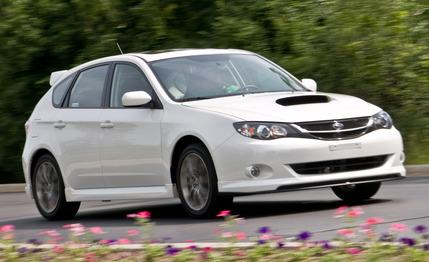 Short Take Road Test
Short Take Road Test
The Subaru Impreza WRX is a car that’s perfect for modification, with its willing chassis and 265 hp and 244 lb-ft of torque serving as great foundations for building an all-conquering rally beast. Indeed, it’s rare to find an example that hasn’t been altered in one way or another, and the previous-generation WRX was even offered in a “Tuner Ready” TR trim intended as a factory-built blank slate for bolt-ons and personalization. Although there’s no TR model in the current lineup, don’t think Subie has abandoned the tuner crowd. It offers a whole slew of factory parts for the Rex, most of which carry the added benefit of a factory warranty.
But we wanted to know if spending dough to spice up the plenty-hot WRX was worth it. So we called up Subaru and borrowed a 2009 WRX five-door the company had fitted with several SPT (Subaru Performance Tuning) add-ons. The list was extensive and covered performance and aesthetic elements. The parts that actually did stuff included an STI short-throw shifter ($295), STI shifter bushings ($25), a front strut-tower brace ($230), a lower chassis brace ($200), a turbo heat shield ($49), and a performance exhaust system ($820). Extra style was taken care of by an STI shift knob ($170), footwell illumination ($47), a lip spoiler ($370), and a chrome sport grille ($345).
Skip Some Items to Save Some Bucks
That’s a lot of parts, and they don’t come cheap: The extras totaled more than $2500 before installation. There are, however, a few items that can be skipped to save some coin. The lip spoiler, the grille, and the footwell illumination, for instance, looked really cool but are ultimately nonfunctional, and losing them lops more than $750 off the total. The shift knob is more comfortable to use than the stock knob, but there’s no way it’s worth $170—we’d look for a far less expensive alternative. The shiny turbo shield adds a bit of pop to the engine bay, and it’s not terribly expensive at $50. It retains heat in the turbo (to maintain exhaust gas velocity) and blocks excess heat from further warming the intercooler. But its placement makes the transmission-fluid dipstick damn near impossible to get back into its hole, so we’d be inclined to go with a turbo blanket instead, to preserve the ability to easily check the trans fluid.
The Performance Parts Help Some Test Figures—but Only Just
Although some people might assume the installation of the lower chassis brace (it connects the subframe to the engine support and supposedly increases overall rigidity) and front strut bar might have a dramatic effect on grip, braces such as these are aimed at increasing steering feel and maintaining suspension geometry during aggressive driving, and that’s exactly what they did. Several editors noted that the SPT car suffered from markedly less understeer than a normal WRX. As for grip, the SPT returned a skidpad number of 0.85 g on optional Dunlop SP Sport summer performance tires. That’s decent but only 0.02 g higher than that achieved by the last WRX five-door we tested, which was wearing Bridgestone Potenza RE92A performance all-seasons. Furthermore, the SPT demonstrated 0.02 g lower grip than a 2009 WRX sedan on the same Dunlop performance rubber. So the chassis and the strut braces are perhaps best suited for those looking to autocross or track their WRX, perhaps in combination with upgraded struts and springs, items that actually can help deliver more grip.
Our favorite upgrades were the STI short-throw shifter (go for the STI bushings while you’re at it) and the performance exhaust. The short-throw kit remedies the stock shifter’s slightly vague feel, which can sometimes make it difficult to locate a gear during aggressive driving. The exhaust system will have your WRX talking dirty and inducing the kind of emotions produced by a late-night run to the seedier side of the internet. The low grunts and growls were awesome, yet the sound never got too loud, as is often the case with aftermarket systems. We recorded just six more decibels at idle over stock, four more at wide-open throttle, and only one additional dB at 70 mph.
But quicker shifts (in theory, anyway) and an altered exhaust didn’t help quickness. The WRX SPT turned in a 0-to-60-mph time of 4.8 seconds, 0.1 second slower than the previously tested 2009 WRX sedan. The sedan weighed about 40 fewer pounds than the SPT hatch.
The best thing about Subaru’s SPT parts is that most of them are warranted for the balance of the car’s original 3-year/36,000-mile warranty. That changes to 1 year/unlimited mileage if installed after the factory warranty has expired, although this period applies to the strut bar no matter what, and it must be installed by the owner, as it is intended for off-highway applications only. But the warranty is great; it’s peace of mind that almost no small aftermarket manufacturer can offer. Just be judicious with your money, and you can make an already rewarding car even better.
(For other Subie tuning ideas, check out our Five Steps to Making More Power in Your Subaru WRX.)